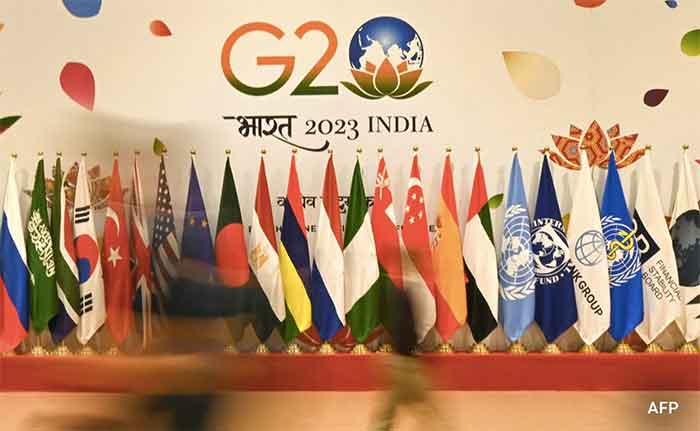
Indian Prime Minister Narendra Modi really wanted to make an impression for his guests and dignitaries, and coarse realities would simply not do. The occasion of the G20 summit presented him with a chance to give the city an aggressive touch-up, touching up a good number of its residents along the way, not to mention the city’s animal life as well. As for those remaining nasties, these could be dressed up, covered, and ignored. Elements of the Potemkin Village formulae – give the impression the peasants are well-fed, for instance – could be used when needed.
One Delhi resident, Saroaj Devi, informed The Guardian about the sharp treatment meted out to him and those living in poverty blighted areas. “They have covered our area so that poor people like us, and poverty in the country, is not witnessed by the people arriving from abroad.”
These coverings, which could really be said to be barriers, are intended as temporary structures, shielding the G20 delegates from the unsightly as they head to their various abodes, a supreme example of detachment from social realities.
This attempt at rendering Delhi’s savoury reality anodyne and safe has also extended to policies of animal removal. Delhi police have been reported as seeking out the aid of civic agencies to deal with the presence of monkeys and stray dogs in the vicinity of Rajghat.
The Municipal Corporation of Delhi (MCD) has not expressly linked the removal of the canines to summitry aesthetics, stating that this is being done “only on an urgent need basis”. The premise is fanciful, given the MCD’s express order made last month to remove stray dogs “from the vicinity of prominent locations in view of the G-20 summit”. It was only withdrawn after provoking much opposition.
This unpleasant picture was not something the opposition was going to let pass. The Indian government, concluded Congress leader Rahul Gandhi, “is hiding our poor people and animals. There is no need to hide India’s reality from our guests.”
Whatever Gandhi’s stance, the slum dwelling Devi is wise enough to realise that poverty is a damn nuisance to all, except when it comes to electioneering opportunities. In such instances, the invisible are brought to life as votes, tangible opportunities. “When it is election time, every politician comes to see us. They eat with us and make promises. But today, they are ashamed of our presence.”
There should certainly be some degree of shame, but hardly for the toiling slum dwellers who shoulder the world’s most populous country. Judging from the figures, the authorities, including the ruling regime, should turn crimson and scurry for cover in burning shame. In Delhi itself, there are 675 clusters populated by 1.55 million people. But do not fear, suggests the confident Union Minister for State Housing and Urban Affairs, Kaushal Kishore. Progress is being made. The Delhi Development Authority (DDA), he recently revealed, had “rehabilitated” 8,379 people in 2022-23. Not to be outdone, the Delhi Urban Shelter Improvement Board (DUSIB) had also its own set of figures: 1,297 people, according to their books, had been rehabilitated in five years.
The meaning of rehabilitation in this context is much like pacification. It is a benign expression enclosed in a fist or, in the Indian context, hidden in a bulldozer. It entails control, management, and dispossession. Slum clearance and forced evictions are favourites. The excitement of G20 summitry has clearly led Prime Minister Modi to speed matters up.
On July 13, 2023, the Concerned Citizens’ collective, with an eclectic membership, released a report documenting testimonies from those affected by the displacement policy ahead of the G20. The findings were based on a public hearing held on May 22, 2023, a horror story in the name of India’s beautification drive. Victims of these projects came forth from Delhi itself, along with Mumbai, Kolkata, Nagpur, Indore, and Udaipur.
The report reveals that 2.5 to 3 million individuals have been displaced, with Delhi alone bearing witness to the razing of 25 slums to the ground. The displacement has not merely taken the form of bulldozed slums; shelters that would have offered temporary relief have also been destroyed. Options for resettlement for the evictees have not been made available.
Residents, according to the report, received the shortest of notices to evacuate; in the case of Delhi’s Bela Estate near Yamuna Floodplains, a mere three hours was offered. Spitefully, the authorities could not leave it at that. Handpumps, for instance, were sabotaged as an incentive to abandon the settlement.
Barriers around the site, according to Akbar, an activist living in East Delhi’s Seemapuri, have also been erected in the immediate aftermath of the evictions to seal off any points or entry or exit. The account he gives is particularly harrowing: a police arrival time of 4-5 am; the barking of orders to vacate within a few hours; the lack of opportunity to seek court intervention. The demolition, once commenced, is done under the cover of police protection, a sinister practice designed to prevent documentary evidence from leaking out.
The police have been particularly mealy mouthed about describing the harsh conditions inflicted on residents. “Global event, Global responsibility – Not a lockdown,” read a full-page advertisement issued by Delhi police welcoming G20 guests. But the requirement for businesses, schools, offices, workplaces, markets, restaurants and non-food shops to effectively cease operations for three days, aided by onerous traffic restrictions, has crippled daily wage earners of the hand-to-mouth variety.
As it happens, the G20 Delhi summit was, as so many of these occasions are, much ado about nothing. The absence of China and Russia turned the occasion into a G18 gathering, removing a good deal of flavour that would otherwise have been present. At the very least it provided Modi an excellent excuse to rough up the slum dwellers, using beautification as a strategy to criminalise the poor.
Dr. Binoy Kampmark was a Commonwealth Scholar at Selwyn College, Cambridge. He currently lectures at RMIT University. Email: [email protected]












































